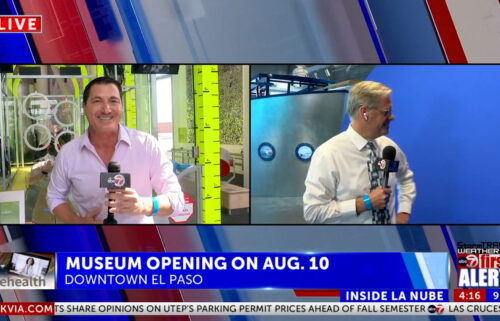‘Cash Back’: Report investigates what restitution for Indigenous land theft could look like
Click here for updates on this story
TORONTO, Ontario (CTV Network) — How much money does Canada owe Indigenous people for the theft of their land, and what could restitution look like?
A new report posed these and other questions as it took a deep dive through the finances behind Canada’s historical and ongoing oppression of Indigenous people.
Called “Cash Back,” the report released on Wednesday is the newest Red Paper from the Yellowhead Institute, an Indigenous-led think tank operating out of Ryerson University. It follows their earlier “Land Back” report, which focused on the dispossession and theft of Indigenous lands specifically.
This time, the lens is pointed at the financial side of the equation.
“Cash Back is about the restitution of stolen wealth,” Shiri Pasternak, research director of the Yellowhead Institute, assistant professor of criminology at Ryerson University and one of the report’s co-authors, told CTVNews.ca.
She explained that the new report looks at how the history of land theft from Indigenous people has “meant a loss of Indigenous livelihood and economic independence.”
The report, which was released with an interactive website packed with graphics, videos and comics, looks at the actual monetary cost of Canada’s theft and commodification of Indigenous lands, as well as the ways that Canada perpetuates poverty for Indigenous people through policies and court decisions that limit their economic efforts and options.
“This project is a collaboration of around 40 Indigenous thinkers, leaders, academics, activists, youth, as well as non-Indigenous allies and academics in cooperation with a half a dozen artists, animators and creators as well,” Pasternak said.
Some of the key findings include an investigation into how housing deteriorated on reserves that were under a government debt program meant to help the communities.
“The problem is political and it’s that Indigenous rights aren’t considered an urgent need or a right,” Pasternak said. “And so the problem just keeps getting passed from one government to the other. And the underlying issue just deepens and deepens the impacts from one generation to the next.”
TRACKING THE MONEY
The report, laid out in three parts, points out that Canada’s economy is intrinsically tied to land — through extraction of resources or simply occupation of space — and thus intrinsically tied to Indigenous lands.
While Canada derives monetary gain from the waterways and lands that were here long before colonizers arrived, First Nations from coast to coast are left out of that wealth.
“First Nations were left stranded on a vast archipelago of reserves and settlements, denied access to their wealth in territory,” the report states.
In Part One, the report looks at the history of Canada’s theft of Indigenous lands and wealth, going all the way back to the sale of Rupert’s Land, when Hudson’s Bay Company (HBC) sold a third of what is now Canada to the country shortly after Confederation, despite the fact that it was made up of the territories of numerous First Nations.
The report estimated that First Nations received the equivalent of $50 million through annuities paid to those who signed treaties after the transfer of Rupert’s Land, but noted that many descendants “never even saw these funds.”
Meanwhile, HBC and Canadian rail companies made approximately $97.5 million and $107 million respectively from the transfer of the land. While HBC only sold the deed to Canada for $1.5 million, the report estimates that they made profits of around $96 million from other land sales, in addition to retail and resource extraction projects.
First Nations were also often coerced into selling their lands to the Department of Indian Affairs at a much lower price than corporations such as HBC could sell land at.
“What you can see there in a few figures is the impacts of the intergenerational wealth that Hudson’s Bay Company and the railroad companies and colonization companies were able to accumulate through the dispossession of Indigenous lands compared to the amount of lands that were allotted to Indigenous people and the treaty annuities that were paid out to them there,” Pasternak said.
Part Two of the report looks at the fiscal policies around Indigenous communities and how services have been underfunded, looking at things such as education and housing.
According to the report, Canada has tried to put a positive spin on things by embracing policies of stepping back to allow Indigenous communities to exercise self-government, but in the process, has failed to provide the funding or resources necessary for Indigenous communities to truly recover from damage done by Canada.
“What you have is, on the face of it, what looks like the government responding and recognizing Indigenous demands for self-determination,” Pasternak said. “But actually if you follow the money, what you see are massive discrepancies in funding to First Nations governments compared to other governments, and also then a blaming game of First Nations for poverty on their reserves or in their communities, when none of the resources have accompanied the transfer of responsibilities to First Nation bands.”
A MAN-MADE HOUSING CRISIS
The second section also looks at something called the Default Management and Prevention Policy (DPMP), a debt program that is intended to assist First Nations that have fallen into debt.
Between 2011 and 2016, the report found, communities under DPMP saw an average increase of 24 homes in need major repair, and a decrease of around 10 suitable homes.
“This default policy is meant to help and support communities that fall into debt,” Pasternak said. “What we found is that the opposite actually happened: communities tend to languish under the policy and in that languishing, their infrastructure also deteriorates at a really rapid rate.
“So we found extremely high correlations of housing deterioration for communities that were under this debt management policy that’s meant to pull them out of deficit, and instead it pushed people deeper and deeper into these infrastructure debts that have lasting intergenerational impacts.”
She explained that since bands were intended to be focused on getting out of debt, there were rules for communities under DPMP about not applying funds to things like housing infrastructure or basic maintenance. But if those things go neglected for long enough, they are much more expensive to fix later on, compounding the debt problem for communities, especially since some communities were under DPMP for more than a decade, the report found.
One community Pasternak spoke to ended up on the hook for $15 million extra to undo the damage of being unable to maintain the lock system around their community using band funds for years due to the DPMP.
“The major problem is underfunding,” Pasternak said. “There’s no surpluses on reserve. The communities are constantly trying to make the most out of too little, and then they get put under debt management and they have to save money somehow. Well, how can you save money if you’re already facing systemic underfunding?”
THE QUESTION OF ‘CASH BACK’
The third part of the report goes into the title itself: How can Indigenous people get that cash back?
“We understand ‘Cash Back’ to fall into categories of redress, compensation and restitution,” Pasternak said. “Some of the most well-known forms of reparations in Canada for Indigenous people have unfolded through class-action lawsuits, for example, the Indian residential school and sixties scoop settlements.”
The report points out that relying on lawsuits is not a guaranteed way to receive justice – of the 24 lawsuits between 1993 and 2019 which covered topics such as the cutting of funding for Indigenous groups, denial of housing services and being placed under third party management, only five were won.
One strategy to generate more money to correct underfunding for Indigenous communities could be a wealth tax, the report suggests.
“If you introduce a wealth tax, you actually can generate enough money to cover what have been estimated as the major deficits for infrastructure funding on reserves, as well as funds for education and for language,” Pasternak said.
Indigenous people have also called for more funding for things like child welfare, as well as annuities “to be paid out based on the resources extracted from their land.” Activists have suggested that funds could be divested from police organizations to Indigenous groups.
“There are also proposals for treaty-based funding, so direct funding from the treasury board to communities that would bypass the intense bureaucracy and paternalism of the department of Indigenous affairs,” Pasternak said, adding that treaty scholars point out that many original treaties include language “that provides for the ongoing sharing of the resources of the land.”
One way to get cash back would be, of course, to get land back.
Eliminating the idea of “Crown land” and giving Indigenous people control over the territories again would be “the most direct form of restitution,” the report stated, describing how if Indigenous people were in control of the territories, they would receive funds from land leases and taxation and receive payment that matched the worth of the land taken from them.
Another aspect of the complicated system keeping Indigenous people from opportunities is the way the courts can prevent them from engaging in Canada’s economy or creating their own opportunities.
The report details several cases where Canadian courts decided whether Indigenous people were allowed to catch and sell fish, and, if they were, whether they were required to be regulated by the Crown or not. Other court cases have seen Indigenous people barred from regulating their own high-stakes gaming operations, despite their right to self-government.
In 2014, the federal government passed Bill C-10 to boost powers to criminalize “contraband tobacco,” with an explicit mention of the booming independent Mohawk tobacco industry, which Canada saw as illegal.
Even when the courts rule in favour of Indigenous people’s treaty rights, they can face huge backlash, such as the harassment and attacks that Mi’kmaq fishers in Nova Scotia suffered in 2020 from non-Indigenous fishers.
“As soon as Indigenous people seek to participate, even in a modest way, in those commercial economies, the backlash is immediate and extreme,” Pasternak said.
The report suggests that one of the reasons Canada is afraid of Indigenous people having financial independence is that it is afraid of the competition.
Pasternak said Canadians should “stop and think about why they’re so threatened by a reckoning of Indigenous rights.”
“Could it be because we have been the beneficiaries of (colonization), and now is the time for that theft to end, and we’re all going to have to adapt and accommodate the decolonization process?”
One of the things she hopes will come from this report is the disruption of the persistent stereotype that Indigenous people get “handouts” from the government.
“There’s a lot of stereotypes about free money that is distributed to Indigenous people,” Pasternak said. “You see it in the comment sections of newspapers, where people feel like taxpayer money is being spent on Indigenous people and ‘where are the results’ and so on.
“I think one of the important aims of the report, or one of the outcomes that I hope for, is that this provides the diagnostic to really understand that, in fact, the opposite is true. There’s been a major discrepancy in the way that First Nations are funded compared to other jurisdictions.”
Edited by CTVNews.ca Writer Ben Cousins
Please note: This content carries a strict local market embargo. If you share the same market as the contributor of this article, you may not use it on any platform.
ctvnews.caproducers@bellmedia.ca




